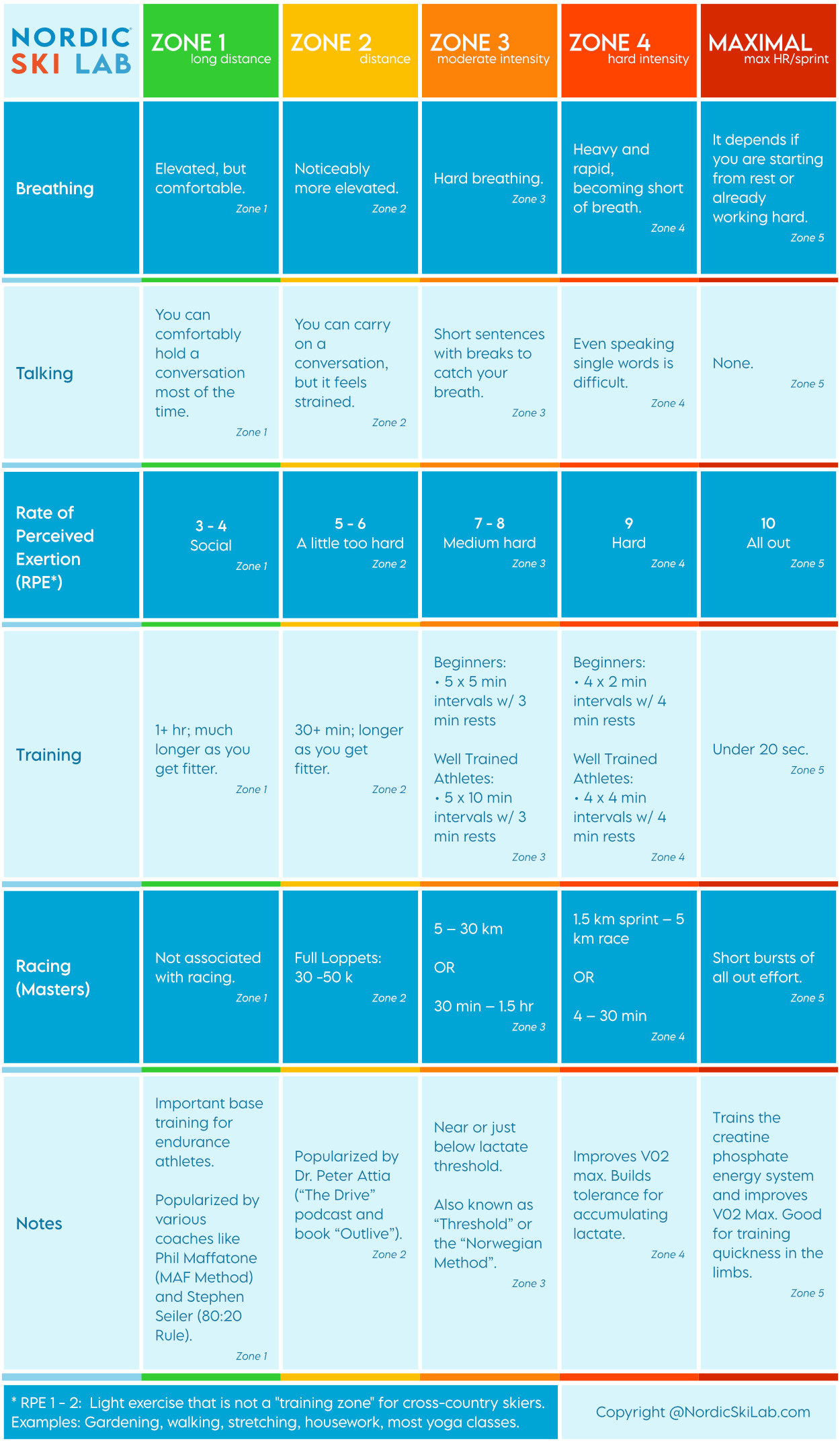Training Zones for Cross-Country Skiers (with Demo Videos)

Training Zones
We designed a 🚀 5 day challenge that teaches all the training zones. Check it out. It’s free!
Exercising at different levels of intensity has health and performance benefits for cross-country skiers of all ages. We use these training Zones:
💚 Zone 1 Long Distance
💛 Zone 2 Distance
🧡 Zone 3 Moderate Intensity
❤️ Zone 4 Hard Intensity
♥️ Max (Sprinting or longer all out efforts)
The benchmarks for breathing and talking are reliable subjective markers of exercise intensity. Rating exercise intensity numerically, on a 1 – 10 scale, is unnecessarily complicated. (10 numbers is too many.) But the 1 – 10 Rate of Perceived Exertion (RPE) scale is widespread, so we included it.
There aren’t clear boundaries between zones; so don’t overthink it. Mix high and low intensity training on a weekly basis. Keep your low effort training easy enough that it doesn’t interfere with your ability to go hard during interval training sessions.
Lactate Levels
Zone 1: 1-1.5 mmol/L
Zone 2: 1.5-2 mmol/L
Zone 3: 2-4 mmol/L
Zone 4: 4 mmol/L + (Can go up to 15 mmol/L or higher for some people with good lactate producing ability).
Aerobic Threshold = 2 mmol/L (Zone 2 – 3 turn point)
Anaerobic Threshold = 4mmol/L (Zone 3 – 4 turn point)
5 Day Challenge
Learn Your Training Zones
🚀 Boost your fitness with our free and fun 5 Day Challenge.
5 daily workouts, each focusing on a specific zone.
Video demos of every training zone.
Learn to control your effort and stay in targeted training zones.
Training Zone Demonstrations
💚 Zone 1 - Long Distance
Training in Zone 1 involves long, easy efforts at a conversational pace. This is the foundation of endurance training, crucial for building a solid aerobic base.
Lactate
Zone 1: 1-1.5 mmol/L
Benefits
- Physiological: Improves aerobic capacity and fat metabolism, aiding in overall endurance and recovery.
- Anatomical: Enhances capillary density and mitochondrial function.
- Mental: Provides a mental break, reducing stress and preventing burnout.
Zone 1 Demos

💛 Zone 2 - Distance

Zone 2 workouts are slightly more intense than Zone 1 but still focus on maintaining a steady, sustainable pace. Cross-country skiers tend to avoid Zone 2 in training because it doesn’t offer many additional benefits over zone 1 and can add fatigue that makes it hard to get the most out of zone 3 and zone 4 interval training.
Lactate
Zone 2: 1.5-2 mmol/L
Benefits
- Physiological: Builds aerobic endurance, optimizing fat burning and cardiovascular efficiency.
- Anatomical: Strengthens heart muscles and improves oxygen delivery to muscles.
- Mental: Enhances focus and discipline through sustained effort.
Zone 2 Demos
🧡 Zone 3 - Moderate Intensity

Also known as “Tempo”. Tempo training in Zone 3 pushes the athlete to a comfortably hard pace, usually just below the lactate threshold. It’s a balance between endurance and high-intensity training, ideal for improving stamina.
During zone 3 intervals, the goal is to exercise for extended periods near, but below, anaerobic threshold. These types of intervals can range from several minutes to an hour or more, so it is important to pace these intervals appropriately.
Lactate
Zone 3: 2-4 mmol/L
Benefits
- Physiological: Increases lactate threshold, allowing for sustained moderate-high intensity efforts.
- Anatomical: Boosts muscle endurance and improves overall stamina.
- Mental: Develops mental toughness and the ability to maintain pace under moderate stress.
Zone 3 Demos
❤️ Zone 4 - Hard Intensity

Also known as “Threshold”. Training in Zone 4 involves high-intensity efforts that challenge the athlete near their maximum aerobic capacity. These workouts are shorter but very demanding, crucial for improving speed and performance.
Lactate
Zone 4: 4 mmol/L + (Can go up to 15 mmol/L or higher for some people with good lactate producing ability).
Benefits
- Physiological: Maximizes aerobic capacity and improves VO2 max.
- Anatomical: Enhances muscle power and efficiency in oxygen usage.
- Mental: Builds resilience and ability to cope with high-intensity efforts.
Zone 4 Demos
♥️ Maximal/Sprinting

The final level is very short, all-out efforts. It varies based on context; whether you are starting from a low-ish heart rate or sprinting at the end of a race.
Benefits
- Physiological:
- Sprints from a low-ish heart rate: Enhances quickness, speed, and neuromuscular coordination.
- End of Zone 3/4 interval: Boosts anaerobic capacity and increases muscle tolerance to lactic acid.
- Anatomical:
- Sprinting develops fast-twitch muscle fibres.
- End of Zone 3/4 interval: Strengthens muscles for explosive power and endurance.
- Mental:
- Sprinting sharpens mental agility and reaction time.
- End of Zone 3/4 interval: Builds extreme mental fortitude and pain tolerance.



